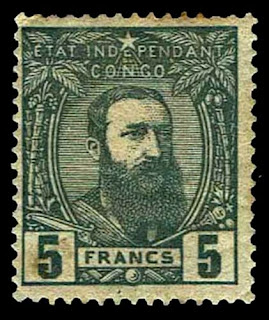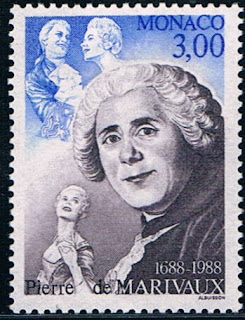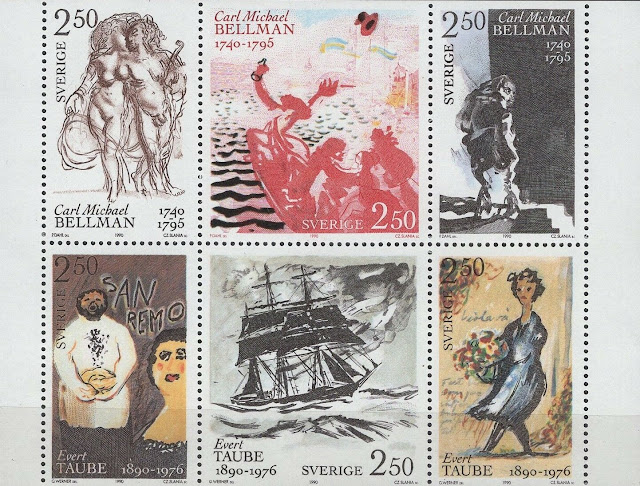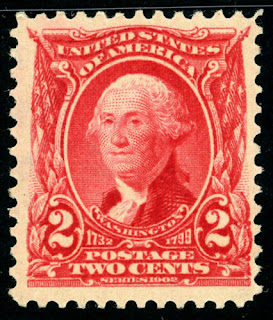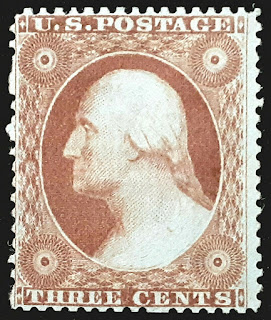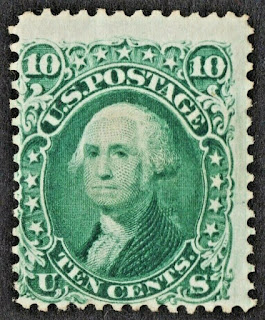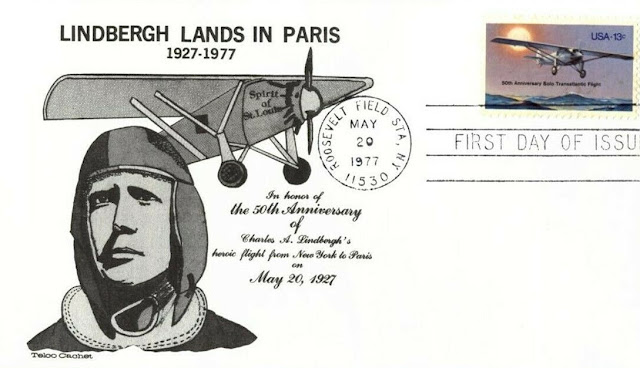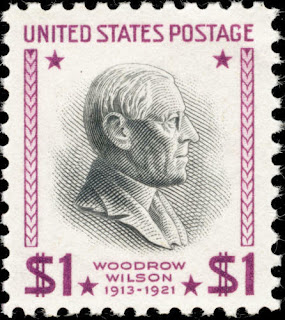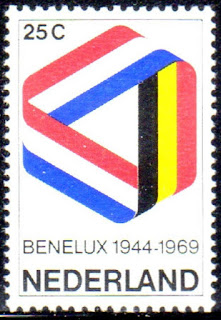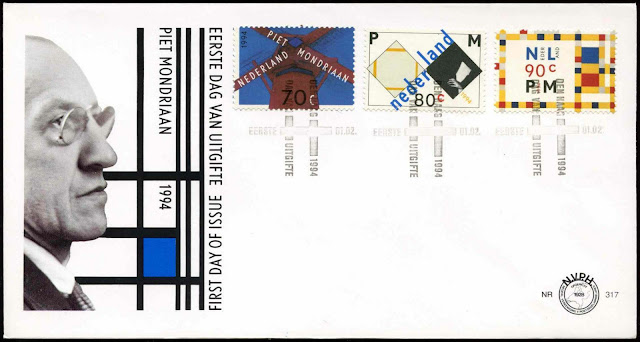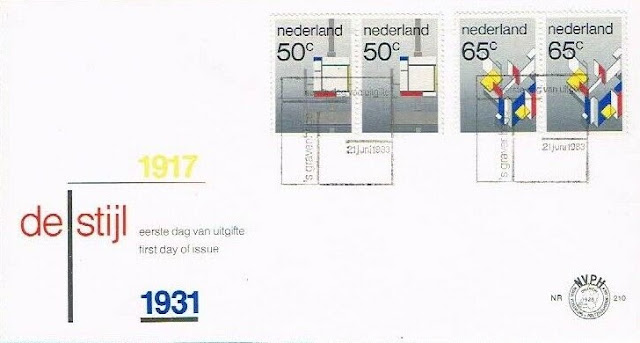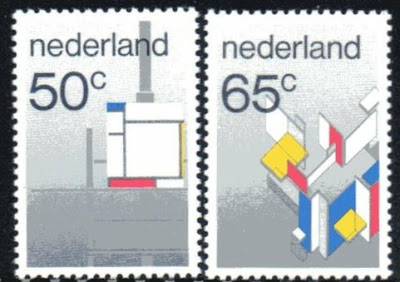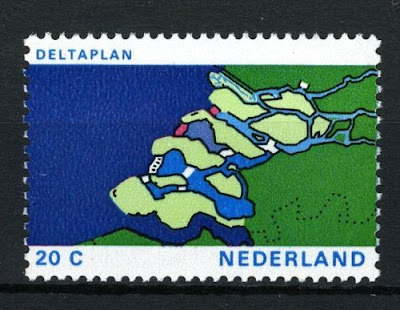Wednesday, February 05, 2020
February 5th in stamps Leopold II Congo, Citroën , Penkala
1885 – King Leopold II of Belgium establishes the Congo as a personal possession.
Leopold II (9 April 1835 – 17 December 1909) was King of the Belgians from 1865 to 1909. Born in Brussels as the second but eldest surviving son of Leopold I and Louise of Orléans, he succeeded his father to the Belgian throne in 1865 and reigned for 44 years until his death – the longest reign of any Belgian monarch. He died without surviving male heirs. The current Belgian king descends from his nephew and successor, Albert I.
Leopold was the founder and sole owner of the Congo Free State, a private project undertaken on his own behalf. He used Henry Morton Stanley to help him lay claim to the Congo, the present-day Democratic Republic of the Congo. At the Berlin Conference of 1884–1885, the colonial nations of Europe authorized his claim by committing the Congo Free State to improving the lives of the native inhabitants. Leopold ignored these conditions and ran the Congo using the mercenary Force Publique for his personal gain. He extracted a fortune from the territory, initially by the collection of ivory, and after a rise in the price of rubber in the 1890s, by forced labor from the native population to harvest and process rubber. He used great sums of the money from this exploitation for public and private construction projects in Belgium during this period. He donated the private buildings to the state before his death, to preserve them for Belgium.
Leopold's administration of the Congo was characterized by murder, torture, and atrocities, resulting from notorious systematic brutality. The hands of men, women, and children were amputated when the quota of rubber was not met. These and other facts were established at the time by eyewitness testimony and on site inspection by an international Commission of Inquiry (1904).
Millions of the Congolese people died: modern estimates range from 1 million to 15 million deaths, with a consensus growing around 10 million. Some historians argue against this figure, citing the absence of reliable censuses, the enormous mortality of diseases such as smallpox or sleeping sickness, and the fact that there were only 175 administrative agents in charge of rubber exploitation.
In 1908, the reports of deaths and abuse induced the Belgian government to take over the administration of the Congo from Leopold.
Stamps from Belgium and Belgian Congo depicting Leopold II
1878 Born: André Citroën, French engineer and businessman, founded Citroën (d. 1935)
André-Gustave Citroën (5 February 1878 – 3 July 1935) was a French industrialist and freemason of Dutch and Polish Jewish origin. He is remembered chiefly for the make of car named after him, but also for his application of double helical gears.
Citroën founded the Citroën automobile company in 1919, leading it to become the fourth largest automobile manufacturer in the world by the beginning of the 1930s. Costs for developing the model Traction Avant, which improved the sales for the company, led to bankruptcy in 1934. It was taken over by the main creditor Michelin, who had provided tires for the cars.
He died in Paris, France, of stomach cancer in 1935 and was interred in the Cimetière du Montparnasse, the funeral being led by the Chief Rabbi of Paris.
Stamps depicting Citroën cars
1922 Died: Slavoljub Eduard Penkala, Croatian engineer, invented the mechanical pencil (b. 1871)
Slavoljub Eduard Penkala (20 April 1871 – 5 February 1922) was a Croatian engineer and inventor of Dutch-Polish descent. Eduard Penkala was born in Liptószentmiklós (now Liptovský Mikuláš), then part of Austria-Hungary, to Franciszek Pękała, who was of Polish heritage, and Maria Pękała (née Hannel), who was of Dutch descent. He attended the University of Vienna and Royal Saxon Polytechnic Institute, graduating from the latter on March 25, 1898, and going on to earn a doctorate in organic chemistry. During his studies, he attended violin lessons where he met his future wife, pianist Emily Stoffregen. He then moved with his wife to Zagreb (which was then in the Kingdom of Croatia-Slavonia). To mark his loyalty to his new homeland, he took on the Croatian name Slavoljub (the equivalent of slavophile), becoming a naturalized Croat.
He became renowned for further development of the mechanical pencil (1906) - then called an "automatic pencil" - and the first solid-ink fountain pen (1907). Collaborating with an entrepreneur by the name of Edmund Moster, he started the Penkala-Moster Company and built a pen-and-pencil factory that was one of the biggest in the world at the time. The company, now called TOZ Penkala, still exists today.
Croatian stamp issued to commemorate Penkala
Tuesday, February 04, 2020
February 4th in stamps de Marivaux, Bellman, Washington, Erhard, Tadeusz Kościuszko, Lindbergh, Hendrik Lorentz
1688 Born: Pierre de Marivaux, French author and playwright (d. 1763)
Pierre Carlet de Chamblain de Marivaux (4 February 1688 – 12 February 1763), commonly referred to as Marivaux, was a French novelist and dramatist.
He is considered one of the most important French playwrights of the 18th century, writing numerous comedies for the Comédie-Française and the Comédie-Italienne of Paris. His most important works are Le Triomphe de l'amour, Le Jeu de l'amour et du hasard and Les Fausses Confidences. He also published a number of essays and two important but unfinished novels, La Vie de Marianne and Le Paysan parvenu.
Stamps from Monaco and France depicting de Marivaux
1740 Born: Carl Michael Bellman, Swedish poet and composer (d. 1795)
Carl Michael Bellman (4 February 1740 – 11 February 1795) was a Swedish songwriter, composer, musician, poet and entertainer. He is a central figure in the Swedish song tradition and remains a powerful influence in Swedish music, as well as in Scandinavian literature, to this day. He has been compared to Shakespeare, Beethoven, Mozart, and Hogarth, but his gift, using elegantly rococo classical references in comic contrast to sordid drinking and prostitution—at once regretted and celebrated in song—is unique.
Bellman is best known for two collections of poems set to music, Fredman's songs (Fredmans sånger) and Fredman's epistles (Fredmans epistlar). Each consists of about 70 songs. The general theme is drinking, but the songs "most ingeniously" combine words and music to express feelings and moods ranging from humorous to elegiac, romantic to satirical.
Bellman's patrons included King Gustav III of Sweden, who called him a master improviser. Bellman's songs continue to be performed and recorded by musicians from Scandinavia and in other languages, including English, French, German, Italian and Russian. Several of his songs including Gubben Noak and Fjäriln vingad are known by heart by many Swedes. His legacy further includes a museum in Stockholm and a society that fosters interest in him and his work.
Swedish stamps depicting Bellman
1746 Born: Tadeusz Kościuszko, Polish-Lithuanian general and engineer (d. 1817)
Andrzej Tadeusz Bonawentura Kościuszko (English: Andrew Thaddeus Bonaventure Kosciuszko;4 or 12 February 1746 – 15 October 1817) was a Polish-Lithuanian military engineer, statesman, and military leader who became a national hero in Poland, Lithuania, Belarus, and the United States. He fought in the Polish–Lithuanian Commonwealth's struggles against Russia and Prussia, and on the US side in the American Revolutionary War. As Supreme Commander of the Polish National Armed Forces, he led the 1794 Kościuszko Uprising.
Kościuszko was born in February 1746, in a manor house on the Mereczowszczyzna estate in Brest Litovsk Voivodeship, Grand Duchy of Lithuania, a part of the Polish–Lithuanian Commonwealth. At age 20, he graduated from the Corps of Cadets in Warsaw, Poland. After the start of the civil war in 1768, Kościuszko moved to France in 1769 to study. He returned to the Commonwealth in 1774, two years after the First Partition, and was a tutor in Józef Sylwester Sosnowski's household. In 1776, Kościuszko moved to North America, where he took part in the American Revolutionary War as a colonel in the Continental Army. An accomplished military architect, he designed and oversaw the construction of state-of-the-art fortifications, including those at West Point, New York. In 1783, in recognition of his services, the Continental Congress promoted him to brigadier general.
Upon returning to Poland in 1784, Kościuszko was commissioned as a major general in the Polish–Lithuanian Commonwealth Army in 1789. After the Polish–Russian War of 1792 resulted in the Second Partition of Poland, he commanded an uprising against the Russian Empire in March 1794 until he was captured at the Battle of Maciejowice in October 1794. The defeat of the Kościuszko Uprising that November led to Poland's Third Partition in 1795, which ended the Commonwealth. In 1796, following the death of Tsaritsa Catherine II, Kościuszko was pardoned by her successor, Tsar Paul I, and he emigrated to the United States. A close friend of Thomas Jefferson's, with whom he shared ideals of human rights, Kościuszko wrote a will in 1798, dedicating his U.S. assets to the education and freedom of the U.S. slaves. Kościuszko eventually returned to Europe and lived in Switzerland until his death in 1817. The execution of his testament later proved difficult, and the funds were never used for the purpose Kościuszko intended.
Stamps from the US and Poland depicting Tadeusz Kosciuszko
George Washington (February 22, 1732 – December 14, 1799) was an American political leader, military general, statesman, and Founding Father who served as the first president of the United States from 1789 to 1797. Previously, he led Patriot forces to victory in the nation's War for Independence. He presided at the Constitutional Convention of 1787, which established the U.S. Constitution and a federal government. Washington has been called the "Father of His Country" for his manifold leadership in the formative days of the new nation.
Washington received his initial military training and command with the Virginia Regiment during the French and Indian War. He was later elected to the Virginia House of Burgesses and was named a delegate to the Continental Congress, where he was appointed Commanding General of the Continental Army. He commanded American forces, allied with France, in the defeat and surrender of the British during the Siege of Yorktown. He resigned his commission after the Treaty of Paris in 1783.
Washington played a key role in adopting and ratifying the Constitution and was then elected president (twice) by the Electoral College. He implemented a strong, well-financed national government while remaining impartial in a fierce rivalry between cabinet members Thomas Jefferson and Alexander Hamilton. During the French Revolution, he proclaimed a policy of neutrality while sanctioning the Jay Treaty. He set enduring precedents for the office of president, including the title "President of the United States", and his Farewell Address is widely regarded as a pre-eminent statement on republicanism.
Washington owned slaves, and in order to preserve national unity he supported measures passed by Congress to protect slavery. He later became troubled with the institution of slavery and freed his slaves in a 1799 will. He endeavored to assimilate Native Americans into Anglo-American culture but combated indigenous resistance during occasions of violent conflict. He was a member of the Anglican Church and the Freemasons, and he urged broad religious freedom in his roles as general and president. Upon his death, he was eulogized as "first in war, first in peace, and first in the hearts of his countrymen". He has been memorialized by monuments, art, geographical locations, stamps, and currency, and many scholars and polls rank him among the greatest American presidents.
US stamps depicting George Washington
1897 Born: Ludwig Erhard, German soldier and politician, 2nd Chancellor of West Germany (d. 1977)
Ludwig Wilhelm Erhard (4 February 1897 – 5 May 1977) was a German politician affiliated with the CDU, and the second Chancellor of the Federal Republic of Germany (West Germany) from 1963 until 1966. He is often famed for leading the West German postwar economic reforms and economic recovery (Wirtschaftswunder, German for "economic miracle") in his role as Minister of Economic Affairs under Chancellor Konrad Adenauer from 1949 to 1963. During that period he promoted the concept of the social market economy (soziale Marktwirtschaft), on which Germany's economic policy in the 21st century continues to be based. In his tenure as Chancellor, however, Erhard lacked support from Adenauer, and failed to win the public's confidence in his handling of a budget deficit and his direction of foreign policy. His popularity waned, and he resigned his chancellorship on 1 December 1966.
German stamps depicting Ludwig Wilhelm Erhard
Lindbergh was an officer in the U.S. Army Air Corps Reserve, and he received the United States' highest military decoration, the Medal of Honor, for his transatlantic flight. His achievement spurred interest in both commercial aviation and air mail, which revolutionized the aviation industry, and he devoted much time and effort to promoting such activity.
In March 1932, Lindbergh's infant son, Charles Jr., was kidnapped and murdered in what the American media called the "Crime of the Century". The case prompted the United States Congress to establish kidnapping as a federal crime if the kidnapper crosses state lines with a victim. By late 1935, the hysteria surrounding the case had driven the Lindbergh family into exile in Europe, from which they returned in 1939.
In the years before the United States entered World War II, his non-interventionist stance and statements about Jews led some to suspect he was a Nazi sympathizer, although Lindbergh never publicly stated support for Nazi Germany. He opposed not only the intervention of the United States but also the provision of aid to the United Kingdom. He supported the anti-war America First Committee and resigned his commission in the U.S. Army Air Forces in April 1941 after President Franklin Roosevelt publicly rebuked him for his views. In September 1941, Lindbergh gave a significant address, titled "Speech on Neutrality", outlining his views and arguments against greater American involvement in the war.
Lindbergh did ultimately express public support for the U.S. war effort after the Japanese attack on Pearl Harbor and the subsequent United States declaration of war upon Germany. He flew 50 missions in the Pacific Theater of World War II as a civilian consultant, but did not take up arms as Roosevelt refused to reinstate his Air Corps colonel's commission. In his later years, Lindbergh became a prolific author, international explorer, inventor, and environmentalist, eventually dying of lymphoma in 1974, at age 72.
US stamp and FDC issued to commemorate Lindbergh's transatlantic flight
According to the biography published by the Nobel Foundation, "It may well be said that Lorentz was regarded by all theoretical physicists as the world's leading spirit, who completed what was left unfinished by his predecessors and prepared the ground for the fruitful reception of the new ideas based on the quantum theory." He received many other honors and distinctions, including a term as chairman of the International Committee on Intellectual Cooperation, the forerunner of UNESCO, between 1925 and 1928.
Monday, February 03, 2020
February 3rd in stamps Mendelssohn Junkers, Wilson, Benelux
Here are some events that happened on February 3rd. It could be an event or a person that died or was born on that day
1809 Born: Felix Mendelssohn, German pianist, composer, and conductor (d. 1847)
Jakob Ludwig Felix Mendelssohn Bartholdy (3 February 1809 – 4 November 1847), born and widely known as Felix Mendelssohn, was a German composer, pianist, organist and conductor of the early Romantic period. Mendelssohn's compositions include symphonies, concertos, piano music and chamber music. His best-known works include his Overture and incidental music for A Midsummer Night's Dream, the Italian Symphony, the Scottish Symphony, the oratorio Elijah, the overture The Hebrides, his mature Violin Concerto, and his String Octet. The melody for the Christmas carol "Hark! The Herald Angels Sing" is also his. Mendelssohn's Songs Without Words are his most famous solo piano compositions.
A grandson of the philosopher Moses Mendelssohn, Felix Mendelssohn was born into a prominent Jewish family. He was brought up without religion until the age of seven, when he was baptized as a Reformed Christian. Felix was recognized early as a musical prodigy, but his parents were cautious and did not seek to capitalize on his talent.
Mendelssohn enjoyed early success in Germany, and revived interest in the music of Johann Sebastian Bach, notably with his performance of the St Matthew Passion in 1829. He became well received in his travels throughout Europe as a composer, conductor and soloist; his ten visits to Britain – during which many of his major works were premiered – form an important part of his adult career. His essentially conservative musical tastes set him apart from more adventurous musical contemporaries such as Franz Liszt, Richard Wagner, Charles-Valentin Alkan and Hector Berlioz. The Leipzig Conservatory, which he founded, became a bastion of this anti-radical outlook. After a long period of relative denigration due to changing musical tastes and antisemitism in the late 19th and early 20th centuries, his creative originality has been re-evaluated. He is now among the most popular composers of the Romantic era.
Stamps from Vatican, East Germany and Germany depicting Felix Mendelssohn
1859 Born: Hugo Junkers, German engineer, designed the Junkers J 1 (d. 1935)
Hugo Junkers (3 February 1859 – 3 February 1935) was a German aircraft engineer and aircraft designer who pioneered the design of all-metal airplanes and flying wings. His company, Junkers Flugzeug- und Motorenwerke AG (Junkers Aircraft and Motor Works), was one of the mainstays of the German aircraft industry in the years between World War I and World War II. His multi-engined, all-metal passenger- and freight planes helped establish airlines in Germany and around the world.
In addition to aircraft, Junkers also built both diesel and petrol engines and held various thermodynamic and metallurgical patents. He was also one of the main sponsors of the Bauhaus movement and facilitated the move of the Bauhaus from Weimar to Dessau (where his factory was situated) in 1925.
Amongst the highlights of his career were the Junkers J 1 of 1915, the world's first practical all-metal aircraft, incorporating a cantilever wing design with virtually no external bracing, the Junkers F 13 of 1919 (the world's first all-metal passenger aircraft), the Junkers W 33 (which made the first successful heavier-than-air east-to-west crossing of the Atlantic Ocean), the Junkers G.38 "flying wing", and the Junkers Ju 52, affectionately nicknamed "Tante Ju", one of the most famous airliners of the 1930s.
When the Nazis came into power in 1933 they requested Junkers and his businesses aid in the German re-armament. When Junkers declined, the Nazis responded by demanding ownership of all patents and market shares from his remaining companies, under threat of imprisonment on the grounds of High Treason. In 1934 Junkers was placed under house arrest, and died at home in 1935 during negotiations to give up the remaining stock and interests in Junkers. Under Nazi control, his company produced some of the most successful German warplanes of the Second World War.
Some German and Bulgarian stamps depicting Junkers planes
1924 Died: Woodrow Wilson, American historian, academic, and politician, 28th President of the United States, Nobel Prize laureate (b. 1856)
Thomas Woodrow Wilson (December 28, 1856 – February 3, 1924) was an American statesman, lawyer, and academic who served as the 28th president of the United States from 1913 to 1921. A member of the Democratic Party, Wilson served as the president of Princeton University and as the 34th governor of New Jersey before winning the 1912 presidential election. As president, he oversaw the passage of progressive legislative policies unparalleled until the New Deal in 1933. He also led the United States into World War I in 1917, establishing an activist foreign policy known as "Wilsonianism." He was the leading architect of the League of Nations.
Born in Staunton, Virginia, Wilson spent his early years in Augusta, Georgia, and Columbia, South Carolina. After earning a Ph.D. in political science from Johns Hopkins University, Wilson taught at various schools before becoming the president of Princeton. As governor of New Jersey from 1911 to 1913, Wilson broke with party bosses and won the passage of several progressive reforms. His success in New Jersey gave him a national reputation as a progressive reformer, and he won the presidential nomination at the 1912 Democratic National Convention. Wilson defeated incumbent Republican President William Howard Taft and Progressive Party nominee Theodore Roosevelt to win the 1912 presidential election, becoming the first Southerner to be elected president since the American Civil War.
During his first term, Wilson presided over the passage of his progressive New Freedom domestic agenda. His first major priority was the passage of the Revenue Act of 1913, which lowered tariffs and implemented a federal income tax. Later tax acts implemented a federal estate tax and raised the top income tax rate to 77 percent. Wilson also presided over the passage of the Federal Reserve Act, which created a central banking system in the form of the Federal Reserve System. Two major laws, the Federal Trade Commission Act and the Clayton Antitrust Act, were passed to regulate and break up large business interests known as trusts. To the disappointment of his African-American supporters, Wilson allowed some of his Cabinet members to segregate their departments. Upon the outbreak of World War I in 1914, Wilson maintained a policy of neutrality between the Allied Powers and the Central Powers. He won re-election by a narrow margin in the presidential election of 1916, defeating Republican nominee Charles Evans Hughes.
In early 1917, Wilson asked Congress for a declaration of war against Germany after Germany implemented a policy of unrestricted submarine warfare, and Congress complied. Wilson presided over war-time mobilization but devoted much of his efforts to foreign affairs, developing the Fourteen Points as a basis for post-war peace. After Germany signed an armistice in November 1918, Wilson and other Allied leaders took part in the Paris Peace Conference, where Wilson advocated for the establishment of a multilateral organization, per his "fourteenth point". The resulting League of Nations was incorporated into the Treaty of Versailles and other treaties with the defeated Central Powers, but Wilson was subsequently unable to convince the Senate to ratify that treaty or allow the United States to join the League. Wilson suffered a severe stroke in October 1919 and was incapacitated for the remainder of his presidency. He retired from public office in 1921 and died in 1924. Scholars have generally ranked Wilson as one of the better U.S. presidents, though he has received strong criticism for his actions regarding racial segregation.
US stamps depicting Woodrow Wilson
1958 – Founding of the Benelux Economic Union, creating a testing ground for a later European Economic Community.
The Benelux Union (Dutch: Benelux Unie; French: Union Benelux; Luxembourgish: Benelux-Unioun), also known as simply Benelux, is a politico-economic union and formal international intergovernmental cooperation of three neighboring states in western Europe: Belgium, the Netherlands, and Luxembourg. The name Benelux is a portmanteau formed from joining the first two or three letters of each country's name – Belgium, Netherlands, Luxembourg – and was first used to name the customs agreement that initiated the union (signed in 1944). It is now used more generally to refer to the geographic, economic, and cultural grouping of the three countries.
Since 1944, when a customs union was introduced, cooperation among the governments of Belgium, the Netherlands, and the Grand Duchy of Luxembourg has been a firmly established practice. The initial form of economic cooperation expanded steadily over time, leading in 1958 to the signing of the Treaty establishing the Benelux Economic Union. Initially, the purpose of cooperation among the three partners was to put an end to customs barriers at their borders and ensure free movement of persons, goods and services among the three countries. It was the first example of international economic integration in Europe since the Second World War. The three countries therefore foreshadowed and provided the model for future European integration, such as the European Coal and Steel Community, the European Economic Community (EEC), and the European Community/European Union (EC/EU). The three partners continue to play this pioneering role. They also launched the Schengen process, which came into operation in 1985, promoting it from the outset. Benelux cooperation has been constantly adapted and now goes much further than mere economic cooperation, extending to new and topical policy areas connected with security, sustainable development, and the economy. Benelux models its cooperation on that of the European Union and is able to take up and pursue original ideas. The Benelux countries also work together in the so called 'The Pentalateral Energy Forum' a regional cooperation group formed of five members - the Benelux states, France, Germany, Austria, and Switzerland. Formed ten years ago, the ministers for energy from the various countries represent a total of 200 million residents and 40% of the European electricity network.
On 17 June 2008 Belgium (in all its component parts), the Netherlands, and Luxembourg signed a new Benelux Treaty in The Hague. The purpose of the Benelux Union is to deepen and expand cooperation among the three countries so that it can continue its role as precursor within the European Union and strengthen and improve cross-border cooperation at every level. Through better cooperation between the countries the Benelux strives to promote the prosperity and welfare of the citizens of Belgium, the Netherlands and Luxembourg.
Benelux works together on the basis of an annual plan embedded in a four-year joint work programme.
Benelux seeks region-to-region cooperation, be it with France and Germany (North-Rhine-Westphalia) or beyond with the Baltic States, the Nordic Council, the Visegrad countries, or even further. In 2018 a renewed political declaration was adopted between Benelux and North-Rhine-Westphalia to give the cooperation a further impetus.
Some examples of recent results of Benelux cooperation : automatic level recognition of all diplomas and degrees within the Benelux, a new Benelux Treaty on Police cooperation, common road inspections and a Benelux pilot with digital consignment notes. The Benelux is also committed to working together on adaptation to climate change. On 5 June 2018 the Benelux (Treaty) celebrated its 60 years of existence. In 2018, a Benelux Youth Parliament was created.
The main institutions of the Union are the Committee of Ministers, the Council of the Union, the General Secretariat, the InterParliamentary Consultative Council and the Benelux Court of Justice while the Benelux Office for Intellectual Property cover the same territory but are not part of the Benelux Union.
The Benelux General Secretariat is located in Brussels. It is the central platform of the Benelux Union cooperation. It handles the secretariat of the Committee of Ministers, the Council of Benelux Union and the various committees and working parties. The General Secretariat provides day-to-day support for the Benelux cooperation on the substantive, procedural, diplomatic and logistical levels.
The presidency of the Benelux is held in turn by the three countries for a period of one year. Luxembourg holds the presidency in 2019.
In addition to cooperation based on a Treaty, there is also political cooperation in the Benelux context, including summits of the Benelux government leaders. In 2019 a Benelux summit was held in Luxembourg.
Benelux stamps issued by Belgium, the Netherlands, and Luxembourg
Sunday, February 02, 2020
February 2nd in stamps Mendeleev, Ulysses, James Joyce
1882 Born: James Joyce, Irish novelist, short story writer, and poet (d. 1941)
1922 – Ulysses by James Joyce is published.
James Augustine Aloysius Joyce (2 February 1882 – 13 January 1941) was an Irish novelist, short story writer, poet, teacher, and literary critic. He contributed to the modernist avant-garde and is regarded as one of the most influential and important authors of the 20th century. Joyce is best known for Ulysses (1922), a landmark work in which the episodes of Homer's Odyssey are paralleled in a variety of literary styles, most famously stream of consciousness. Other well-known works are the short-story collection Dubliners (1914), and the novels A Portrait of the Artist as a Young Man (1916) and Finnegans Wake (1939). His other writings include three books of poetry, a play, his published letters and occasional journalism.
Joyce was born in Dublin into a middle-class family. A brilliant student, he briefly attended the Christian Brothers-run O'Connell School before excelling at the Jesuit schools Clongowes and Belvedere, despite the chaotic family life imposed by his father's unpredictable finances. He went on to attend University College Dublin.
In 1904, in his early twenties, Joyce emigrated to continental Europe with his partner (and later wife) Nora Barnacle. They lived in Trieste, Paris, and Zürich. Although most of his adult life was spent abroad, Joyce's fictional universe centres on Dublin and is populated largely by characters who closely resemble family members, enemies and friends from his time there. Ulysses in particular is set with precision in the streets and alleyways of the city. Shortly after the publication of Ulysses, he elucidated this preoccupation somewhat, saying, "For myself, I always write about Dublin, because if I can get to the heart of Dublin I can get to the heart of all the cities of the world. In the particular is contained the universal."
Irish stamps commemorating James Joyce
1907 Died: Dmitri Mendeleev, Russian chemist and academic (b. 1834)
Dmitri Ivanovich Mendeleev (often romanized as Mendeleyev or Mendeleef, 8 February 1834 – 2 February 1907) was a Russian chemist and inventor. He is best remembered for formulating the Periodic Law and creating a farsighted version of the periodic table of elements. He used the Periodic Law not only to correct the then-accepted properties of some known elements, such as the valence and atomic weight of uranium, but also to predict the properties of eight elements that were yet to be discovered.
In 1863, there were 56 known elements with a new element being discovered at a rate of approximately one per year. Other scientists had previously identified periodicity of elements. John Newlands described a Law of Octaves, noting their periodicity according to relative atomic weight in 1864, publishing it in 1865. His proposal identified the potential for new elements such as germanium. The concept was criticized and his innovation was not recognized by the Society of Chemists until 1887. Another person to propose a periodic table was Lothar Meyer, who published a paper in 1864 describing 28 elements classified by their valence, but with no predictions of new elements.
After becoming a teacher in 1867, Mendeleev wrote the definitive textbook of his time: Principles of Chemistry (two volumes, 1868–1870). It was written as he was preparing a textbook for his course. This is when he made his most important discovery. As he attempted to classify the elements according to their chemical properties, he noticed patterns that led him to postulate his periodic table; he claimed to have envisioned the complete arrangement of the elements in a dream:
I saw in a dream a table where all elements fell into place as required. Awakening, I immediately wrote it down on a piece of paper, only in one place did a correction later seem necessary.—Mendeleev, as quoted by Inostrantzev
On 6 March 1869, he made a formal presentation to the Russian Chemical Society, titled The Dependence between the Properties of the Atomic Weights of the Elements, which described elements according to both atomic weight (now called relative atomic mass) and valence. This presentation stated that
The elements, if arranged according to their atomic weight, exhibit an apparent periodicity of properties.
Elements which are similar regarding their chemical properties either have similar atomic weights (e.g., Pt, Ir, Os) or have their atomic weights increasing regularly (e.g., K, Rb, Cs).
The arrangement of the elements in groups of elements in the order of their atomic weights corresponds to their so-called valencies, as well as, to some extent, to their distinctive chemical properties; as is apparent among other series in that of Li, Be, B, C, N, O, and F.
The elements which are the most widely diffused have small atomic weights.
The magnitude of the atomic weight determines the character of the element, just as the magnitude of the molecule determines the character of a compound body.
We must expect the discovery of many yet unknown elements – for example, two elements, analogous to aluminium and silicon, whose atomic weights would be between 65 and 75.
The atomic weight of an element may sometimes be amended by a knowledge of those of its contiguous elements. Thus the atomic weight of tellurium must lie between 123 and 126, and cannot be 128. (Tellurium's atomic weight is 127.6, and Mendeleev was incorrect in his assumption that atomic weight must increase with position within a period.)
Certain characteristic properties of elements can be foretold from their atomic weights.
Mendeleev published his periodic table of all known elements and predicted several new elements to complete the table in a Russian-language journal. Only a few months after, Meyer published a virtually identical table in a German-language journal. Mendeleev has the distinction of accurately predicting the properties of what he called ekasilicon, ekaaluminium and ekaboron (germanium, gallium and scandium, respectively).
Russian and Portuguese stamps depicting Mendeleev and his periodic table
Saturday, February 01, 2020
February 1st in stamps Lisbon Regicide, Mondrian, North Sea flood of 1953, Beatles, Heisenberg
1908 – Lisbon Regicide: King Carlos I of Portugal and Infante Luis Filipe are shot dead in Lisbon.
Dom Carlos I (28 September 1863 – 1 February 1908), known as the Diplomat (Portuguese: o Diplomata) and the Martyr (Portuguese: o Martirizado), was the King of Portugal from 1889 until his assassination in 1908. He was the first Portuguese king to die a violent death since Sebastian in 1578.
Carlos was born in Lisbon, Portugal, the son of King Luís and Queen Maria Pia, daughter of King Victor Emmanuel II of Italy, and was a member of the House of Braganza. He had a brother, Infante Afonso, Duke of Porto. He was baptised with the names Carlos Fernando Luís Maria Víctor Miguel Rafael Gabriel Gonzaga Xavier Francisco de Assis José Simão.
He had an intense education and was prepared to rule as a constitutional monarch. In 1883, he traveled to Italy, the United Kingdom, France and Germany, where he increased his knowledge of the modern civilization of his time. In 1883, 1886 and 1888, he ruled as regent as his father was traveling in Europe, as had become traditional among the Portuguese constitutional kings. His father Luis I advised him to be modest and to study with focus.
His first bridal candidate was one of the daughters of German Emperor Frederick III, but the issue of religion presented an insurmountable problem, and the pressure of British diplomacy prevented the marriage. He then met and married Princess Amélie of Orléans, eldest daughter of Philippe, comte de Paris, pretender to the throne of France.
Carlos became king on 19 October 1889. After the 1890 British Ultimatum, a series of colonial treaties were signed with the United Kingdom of Great Britain and Ireland. One signed in August 1890 defined African colonial borders along the Zambezi and Congo rivers, whereas another signed on 14 October 1899 confirmed colonial treaties of the 17th century. These treaties stabilised the political balance in Africa, ending Portuguese claims of sovereignty on the Pink Map, a geographical conception of how Portuguese colonies would appear on a map if the territory between the coastal colonies of Angola and Mozambique could be connected with territory in central Africa. These central African territories were taken over by Great Britain, however, a concession that was viewed as humiliating in Portugal. The agreements were thus looked upon as unpopular in Portugal and were felt to be disadvantageous to the country.
On 1 February 1908, the royal family returned from the Ducal Palace of Vila Viçosa in Vila Viçosa to Lisbon, where they spent time hunting in Alentejo in the hunting season during the winter. They travelled by train to Barreiro and, from there, they took a steamer to cross the Tagus River and disembarked at Cais do Sodré in central Lisbon. On their way to the royal palace, the open carriage with Carlos I and his family passed through the Terreiro do Paço fronting on the river. While crossing the square, shots were fired from the crowd by two republican activists: Alfredo Luís da Costa and Manuel Buíça.
Buíça, a former army sergeant and sharpshooter, fired five shots from a rifle hidden under his long overcoat. The king died immediately, his heir Luís Filipe was mortally wounded and Prince Manuel was hit in the arm. The queen alone escaped injury. The two assassins were killed on the spot by police and bodyguards; an innocent bystander was also killed in the confusion. The royal carriage turned into the nearby Navy Arsenal, where, about twenty minutes later, Prince Luís Filipe died. Several days later, the younger son, Prince Manuel, was proclaimed king of Portugal; he was the last of the Braganza-Saxe-Coburg and Gotha dynasty and the last king of Portugal as well.
Portuguese stamps depicting Carlos I
1944 Died: Piet Mondrian, Dutch-American painter (b. 1872)
Pieter Cornelis Mondriaan, after 1906 Piet Mondrian (7 March 1872 – 1 February 1944), was a Dutch painter and theoretician who is regarded as one of the greatest artists of the 20th century. He is known for being one of the pioneers of 20th century abstract art, as he changed his artistic direction from figurative painting to an increasingly abstract style, until he reached a point where his artistic vocabulary was reduced to simple geometric elements.
Mondrian's art was highly utopian and was concerned with a search for universal values and aesthetics. He proclaimed in 1914: "Art is higher than reality and has no direct relation to reality. To approach the spiritual in art, one will make as little use as possible of reality, because reality is opposed to the spiritual. We find ourselves in the presence of an abstract art. Art should be above reality, otherwise it would have no value for man." His art, however, always remained rooted in nature.
He was a contributor to the De Stijl art movement and group, which he co-founded with Theo van Doesburg. He evolved a non-representational form which he termed Neoplasticism. This was the new 'pure plastic art' which he believed was necessary in order to create 'universal beauty'. To express this, Mondrian eventually decided to limit his formal vocabulary to the three primary colors (red, blue and yellow), the three primary values (black, white and gray) and the two primary directions (horizontal and vertical). Mondrian's arrival in Paris from the Netherlands in 1911 marked the beginning of a period of profound change. He encountered experiments in Cubism and with the intent of integrating himself within the Parisian avant-garde removed an 'a' from the Dutch spelling of his name (Mondriaan).
Mondrian's work had an enormous influence on 20th century art, influencing not only the course of abstract painting and numerous major styles and art movements (e.g. Color Field painting, Abstract Expressionism and Minimalism), but also fields outside the domain of painting, such as design, architecture and fashion. Design historian Stephen Bayley said: 'Mondrian has come to mean Modernism. His name and his work sum up the High Modernist ideal. I don’t like the word ‘iconic’, so let’s say that he’s become totemic – a totem for everything Modernism set out to be.'
1953 – North Sea flood of 1953 is caused by a heavy storm which occurred overnight, 31 January-1 February 1953; floods strike the Netherlands, Belgium and the U.K.
The 1953 North Sea flood was a major flood caused by a heavy storm that occurred on the night of Saturday, 31 January 1953 and morning of Sunday, 1 February 1953. The floods struck the Netherlands, Belgium, England and Scotland.
A combination of a high spring tide and a severe European windstorm over the North Sea caused a storm tide; the combination of wind, high tide, and low pressure led to a water level of more than 5.6 meters (18.4 ft) above mean sea level in some locations. The flood and waves overwhelmed sea defenses and caused extensive flooding. The Netherlands, a country with 20% of its territory below mean sea level and 50% less than 1 meter (3.3 ft) above sea level and which relies heavily on sea defenses, was worst affected, recording 1,836 deaths and widespread property damage. Most of the casualties occurred in the southern province of Zeeland. In England, 307 people were killed in the counties of Lincolnshire, Norfolk, Suffolk and Essex. Nineteen were killed in Scotland. Twenty-eight people were killed in West Flanders, Belgium.
In addition, more than 230 deaths occurred on water craft along Northern European coasts as well as on ships in deeper waters of the North Sea. The ferry MV Princess Victoria was lost at sea in the North Channel east of Belfast with 133 fatalities, and many fishing trawlers sank.
Stamps issued in 1953 in New Guinea and the Netherlands
After the 1953 flood, governments realized that similar infrequent but devastating events were possible in the future. In the Netherlands the government conceived and constructed an ambitious flood defense system beginning in the 1960s. Called the Delta Works (Dutch: Deltawerken), it is designed to protect the estuaries of the rivers Rhine, Meuse and Scheldt. The system was completed in 1998, with completion of the storm surge barrier Maeslantkering in the Nieuwe Waterweg, near Rotterdam.
Deltaplan stamp issued in 1972
1964 – The Beatles have their first number one hit in the United States with "I Want to Hold Your Hand".
Beatles covers on stamps from Great Britain
1976 Died: Werner Heisenberg, German physicist and academic, Nobel Prize laureate (b. 1901)
Werner Karl Heisenberg (5 December 1901 – 1 February 1976) was a German theoretical physicist and one of the key pioneers of quantum mechanics. He published his work in 1925 in a breakthrough paper. In the subsequent series of papers with Max Born and Pascual Jordan, during the same year, this matrix formulation of quantum mechanics was substantially elaborated. He is known for the Heisenberg uncertainty principle, which he published in 1927. Heisenberg was awarded the 1932 Nobel Prize in Physics "for the creation of quantum mechanics".
He also made important contributions to the theories of the hydrodynamics of turbulent flows, the atomic nucleus, ferromagnetism, cosmic rays, and subatomic particles, and he was instrumental in planning the first West German nuclear reactor at Karlsruhe, together with a research reactor in Munich, in 1957. He was a principal scientist in the German nuclear weapons program during World War II. He travelled to occupied Copenhagen where he met and discussed the German project with Niels Bohr.
Following World War II, he was appointed director of the Kaiser Wilhelm Institute for Physics, which soon thereafter was renamed the Max Planck Institute for Physics. He was director of the institute until it was moved to Munich in 1958, when it was expanded and renamed the Max Planck Institute for Physics and Astrophysics.
German first day cover commemorating Heisenberg



